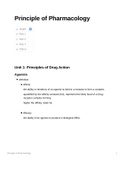Principle of Pharmacology
taught
Rep 1
Rep 2
Rep 3
Status
Unit 1: Principles of Drug Action
Agonists
definition
affinity
the ability or tendency of an agonist to bind to a receptor to form a complex,
quantified by the affinity constant (KA), represent the likely hood of a Drug-
receptor complex forming
higher the affinity, lower ka
efficacy
the ability of an agonist to produce a biological effect
Principle of Pharmacology 1
, potency
a measure of the concentrations of a drug at which is effective
EC50 (C for concentration)
the effective concentration of an agonist which produce 50% of the maximum
possible response
(conc. at 50% response)
ED50 (D for dose)
the effective dose of an agonist which produce 50% of the maximum possible
response
(dose at 50% response)
full agonist and partial agonist
Principle of Pharmacology 2
, to note: no matter how high conc of partial agonist, cannot produce maximal
activation
inverse agonist
drug produce an effect opposite to that agonist, but compete for same receptor,
have -ve efficacy
e.g. antihistamines to histamine H1 receptor
Principle of Pharmacology 3
, pharmacodynamics
(the action of drug on the body, inhibit or enhance)
the effect a drug has on the body enables an appropriate choice of therapeutic
tool
pharmacokinetics
(the action of the body on drug, ADME)
what the body reacts to a drug enables an appropriate dose rate to be selected,
which varies across species
Know how agonists interact with target molecules and the relationship between
concentration and response;
Explain the following terms: affinity, efficacy, potency, EC50 and ED50, spare
receptor hypothesis;
Principle of Pharmacology 4




